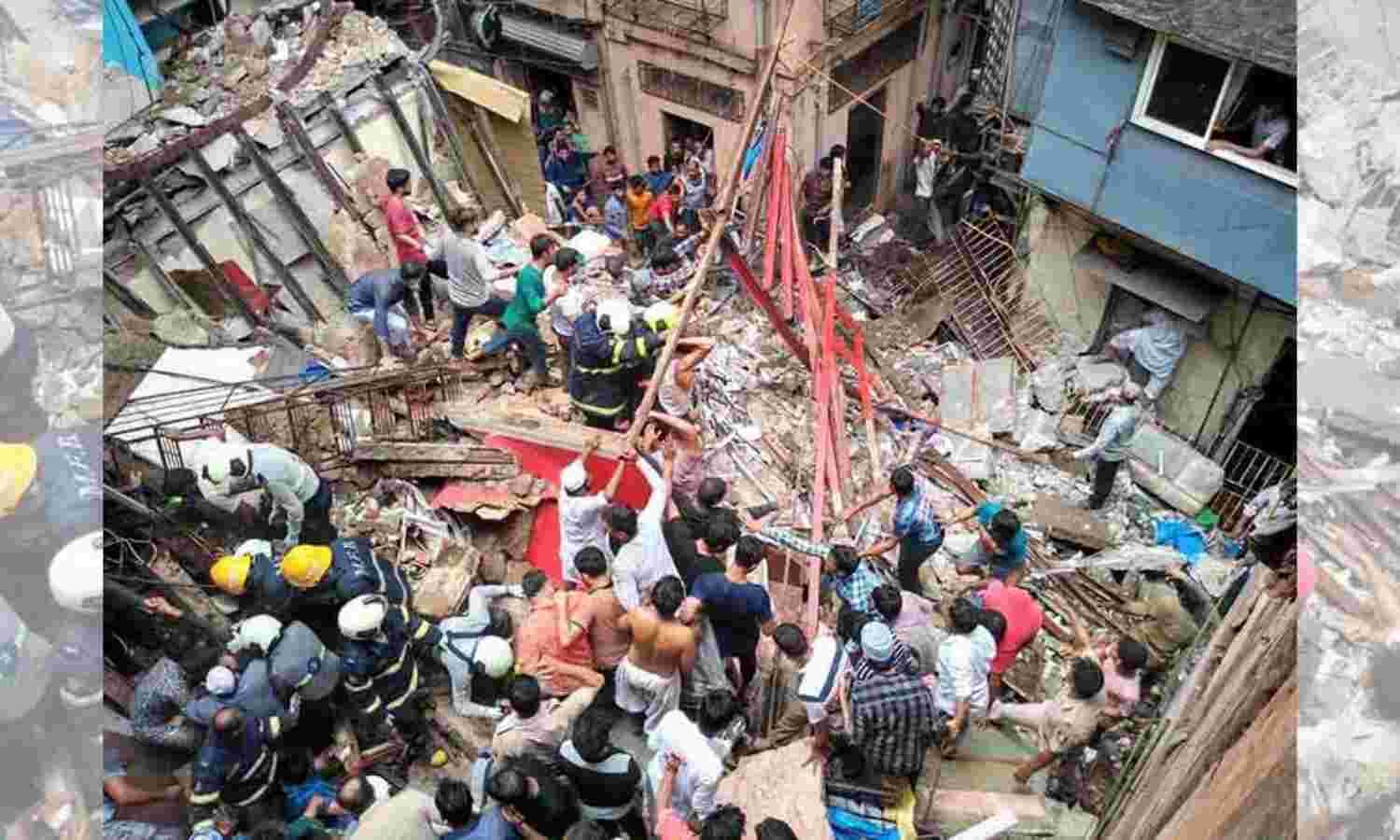499 Mumbai Buildings On Same High-Risk List As One That Collapsed, Trapping Scores

Mumbai: With more than 40 people feared trapped in the collapse of a three-storeyed building in south Mumbai on July 16, 2019--and 499 buildings in the city identified as similarly vulnerable--an IndianSpend analysis of municipal data reveals that the fire- and disaster-management budget for India’s financial capital declined 38% over three years to 2020.
In an extremely unfortunate incident, the Kesarbai bldng in Dongri collapsed at 11.40 am. According to preliminary information, 40 to 50 people are most likely trapped in the debris. 1/2
— माझी Mumbai, आपली BMC (@mybmc) July 16, 2019
2/2 3 teams of NDRF, fire brigade, our disaster management team as well as all senior officials of MCGM are on the site. Rescue work is in progress & we request citizens to cooperate with the authorities.
— माझी Mumbai, आपली BMC (@mybmc) July 16, 2019
The Brihanmumbai Municipal Corporation (BMC) is India’s richest civic body. The decline in its disaster management and fire-brigade budget unfolded alongside a 60% rise in funding, over two years to 2020, to build an eight-lane, 32-km coastal road along the island-city’s western seaboard, according to our analysis of municipal data from 2015-16 to 2019-20.
The inadequacy of the BMC’s fire-and-disaster response was evident in the fact that only one in three emergency calls to the fire brigade in south Mumbai received help within eight minutes--the internationally accepted standard--according to an Indian Institute of Technology (IIT)-Bombay study quoted in the Hindustan Times on June 2, 2019.
The IIT study recommended more fire stations and extra vehicles for the brigade’s fleet to better service south Mumbai, an area with 92,312 people per sq km, compared to 10,796 per sq km in New York, a city with four million fewer people than Mumbai’s 12.4 million.
The dire situation in Mumbai is mirrored nationwide, with 1,830 “structural collapses” reported in 2015, the latest year for which data are available, according to the National Crime Records Bureau. Up to 59% or 1,080 such collapses were of “dwelling-houses/residential buildings”.
That same year, 1,885 people--or five every day--died in “structural collapses”. Of these, 1,109--or three every day--died in “dwelling-houses/residential buildings” collapses.
In the 2019-20 municipal budget, the BMC set aside Rs 201.4 crore or 2% of its capital expenditure, for the Mumbai Fire Brigade. This covers investments for new disaster management equipment, safety gear, vehicles and fire stations.
While this is an 11.5% increase from 2018-19, the fire brigade’s budget is still recovering from a drop of 39.7% and 7.5% over two years to 2018-19. Before that, the BMC’s budget for this head had seen a five-year peak at Rs 273.9 crore in 2016-17.
In 2017-18, the BMC included the coastal road project in its capital expenditure, allocating Rs 1,000 crore ($156 million) for the year. Thereafter, spending on the project rose by 33% in 2018-19 and by 6% in 2019-20.
The July 16 disaster came 709 days after the BMC, on August 7, 2017, identified the Kesarbhai building that collapsed in south Mumbai’s Dongri as a “dangerous structure” that needed to be “vacated & demolished”.
More than 40 people were feared trapped (2 dead, 7 rescued) in a 3-storey building that collapsed in #Mumbai’s Dongri area. Follow this thread for insights into the crumbling building infrastructure of India’s financial capital #MumbaiBuildingCollapse #dongri pic.twitter.com/bNPVkAJwSl
— IndiaSpend (@IndiaSpend) July 16, 2019
The disaster comes 709 days after the #BMC on August 7, 2017, identified the Kesarbhai building that collapsed in south Mumbai’s #Dongri today as a “dangerous structure” that needed to be “vacated & demolished” #MumbaiBuildingCollapsehttps://t.co/XS1TTcD7DD
— IndiaSpend (@IndiaSpend) July 16, 2019
The BMC listed 499 buildings in #Mumbai as “dilapidated”, officially C-1 category, in 2019-20. C-1 buildings are "unsafe/dangerous inhabitable structures” that “need to be vacated and demolished". #MumbaiBuildingCollapse #dongri https://t.co/HY8xi9cOzi pic.twitter.com/85L9PXsGlO
— IndiaSpend (@IndiaSpend) July 16, 2019
The 24 wards in #Mumbai have 467 C-1 buildings (32 listed separately under estate dept), of which 64 or 14% are in N ward encompassing the eastern suburbs. Suburban K-West ward with 5 bldgs has the next highest number. #MumbaiBuildingCollapse #dongri pic.twitter.com/5vD6HHrzZT
— IndiaSpend (@IndiaSpend) July 16, 2019
In the 2019-20 municipal budget, #BMC set aside Rs 201.4 cr, or 2% of its capital expenditure, for the Mumbai Fire Brigade & for investments in new disaster management equipment, safety gear, vehicles & fire stations
— IndiaSpend (@IndiaSpend) July 16, 2019
After dropping 39.7% & 7.5% over 2 yrs to 2018-19, Mumbai’s fire brigade & disaster management budget rose 11.5% in 2019-20. In 2016-17, BMC budget for this head was Rs 273.9 cr, highest in 5 years pic.twitter.com/REtsoR08IT
— IndiaSpend (@IndiaSpend) July 16, 2019
The drop in Mumbai’s fire brigade & disaster management budget corresponds with a rise in spending for the proposed 32-km, 8-lane, Rs 14,000-cr coastal road along the western seaboard of India’s financial capital. #MumbaiBuildingCollapse #dongri pic.twitter.com/c8xZcxuUZb
— IndiaSpend (@IndiaSpend) July 16, 2019
1,830 “structural collapses” were reported in India in 2015, of which 59% or 1,080 were “dwelling-houses/residential buildings”: 2015 National Crime Records Bureau data, latest available. #MumbaiBuildingCollapse #dongrihttps://t.co/6LP1uAow9e
— IndiaSpend (@IndiaSpend) July 16, 2019
5 people died in “structural collapses” every day in 2015 in India (1,885). Of these, 3 died every day (1,109) in collapse of “dwelling-houses/residential buildings”. #MumbaiBuildingCollapse #dongri
— IndiaSpend (@IndiaSpend) July 16, 2019
Of 1,885 deaths due to “structural collapses” nationwide in 2015, Uttar Pradesh reported the most 19% (360), followed by Madhya Pradesh (217) & Maharashtra (187). #MumbaiBuildingCollapse #dongri https://t.co/RxsxD1zhKR
— IndiaSpend (@IndiaSpend) July 16, 2019
— IndiaSpend (@IndiaSpend) July 16, 2019
We welcome feedback. Please write to respond@indiaspend.org. We reserve the right to edit responses for language and grammar.


